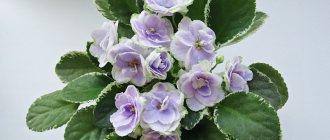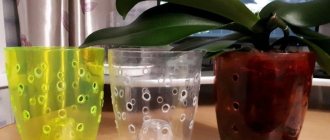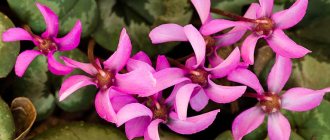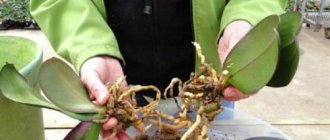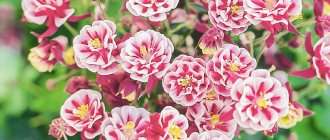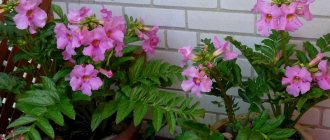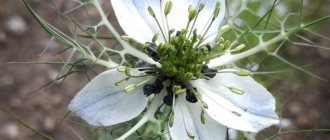Reproduction methods
There are several ways to propagate pelargonium.
Most often, geranium is propagated at home by dividing the bush and cuttings, but it can also be done by seeds. The process is more labor intensive, but the result is a large number of healthy young plants. Propagation by dividing the bush is best done in spring. A plant whose root system has completely filled the pot and is visible through the hole in the bottom of the pot is suitable. An adult bush is watered abundantly and taken out of the pot. The root system is carefully disassembled and, if necessary, cut off with a sterile knife. Each part should have leaves and roots. The cut areas must be treated with activated carbon and cinnamon powder. After separation, the flowers are planted in small pots. 10-14 centimeters in diameter is enough. If the pot is too large, flowering will occur later or will be postponed until the next year until the plant fills the entire volume of the pot with roots. It is necessary to put drainage at the bottom of the pot. You can prepare the soil yourself or purchase it at the store. The soil from the store must be diluted with garden soil and disinfected. To do this, it is calcined in the oven or spilled with a solution of potassium permanganate.
Propagation by cuttings can be carried out throughout the year, but the best results will come from cuttings taken in the spring. During spring pruning, a large number of cuttings remain, which easily take root. The cut branch should have no more than 2-3 leaves. Very large leaves can be cut in half. The cutting is cut at an angle using a sharp knife or blade. It is better to disinfect it first. The cutting is left at room temperature for several hours until the cut is airy. The finished cuttings are placed in a glass of water. It is better to wrap it in dark paper. In the dark, roots will form quickly. You need to add an activated carbon tablet to the water, and cut a cardboard with a hole along the diameter of the neck, into which to place the cutting. It should not sink much in the water, no more than 1 centimeter, otherwise it may begin to rot. Pelargonium takes root easily if it is simply planted in the ground. A regular plastic cup will do for this. Holes are made in it to drain water, fine drainage and soil are poured. The soil should not be very wet, otherwise the plant will not take root and will begin to rot. At first, do not water the cuttings; you can only lightly spray the ground. If it starts to wilt, cover it with a jar.
Propagation by seeds is a long and painstaking process. Before planting, the seeds must be treated. To do this, they are lightly rubbed on fine sandpaper and soaked in the stimulator for 3 hours. Then soak in clean water for another 3 hours. The soil from the store is oversaturated with nutrients, so it is better to make it yourself. Its composition should include peat, river sand and turf soil in a ratio of 1:1:2. The container for the first planting of seeds should be shallow. The seeds are evenly distributed over the surface at a distance of 5 centimeters from each other. Spray with a fine sprayer; if the ground is dry, cover the container with glass. Shoots will appear within a month. After 3-4 leaves appear, you can transplant them into separate cups or directly into small pots.
The process and characteristics of flowering
Geranium is an indoor plant that does not require a lot of time and effort to care for. She requires special care during flowering. As soon as the ovary appears, they evaluate whether anything will interfere with the formation of inflorescences.
Why is it important? For example, leaving the flower pots to be “torn to pieces” by direct sunlight, the flowers will not be bright. In other words, a flowering geranium will turn into a weed without taking into account the features from the list below
- In winter, they provide coolness to the plant. The main thing is to know moderation in everything: air temperature in the room below 10⁰C is unlikely to be beneficial, contributing to its premature awakening from a state of rest.
- The “south” window is an excellent place to place flowerpots with pelargonium. She loves the sun, but not in excess.
- Light and nutrition are two mandatory conditions that must be observed by gardeners who want to enjoy flowering all year round.
- The more branches, the more places for flowering. Shoots are pinched to enhance branching.
- As soon as the flowers fade, remove them.
- Pelargonium rejuvenates and gains strength for growth with regular pruning.
If geranium is grown from seeds, it will bloom 130-140 days after sowing. This will happen when the plant has gained good vegetative mass.
On a note. Many gardeners sow geraniums in pots in early February in order to enjoy the beauty of the flowering plant in May.
How long will flowering last? How many buds will appear? If you do not take care of the geranium, do not feed it or apply fertilizers rich in nitrogen, it will not bloom on the 130-140th day. Everything will happen late, and besides, there will be few flowers. This process will be affected by factors: lighting, watering, temperature.
When the amount of phytohormones is sufficient, the formation of flower primordia will occur. Soon exogenous shoots will appear on the growth cone. Sepals will form, then petals.
After the formation of the anther and filament, the stamens will develop. Carpels look like corymbose leaves on short stalks. Their lower side grows more intensively than the upper, resulting in the formation of a cavity with fused edges.
A style and stigma are formed in the upper part of the carpel. These processes occur inside the kidney.
Once the flower is developed, pollination must occur. To do this, the parts of the plant involved in this process must become free and accessible. It happens in different ways.
If you take a pot of geraniums out into the open air, insects will pollinate the flowers. Self-pollination or artificial pollination can also occur. As soon as this happens, the petals and stamens, stylodes and stigmas will fall off.
The calyx will be preserved, as it is needed to protect the ovary, which will later turn into a fruit. The flowering time of one flower is 3-10 days, and there are up to 50 of them in one inflorescence.
Read our material about what to do with faded flowers and whether you need to prune geraniums.
Where and how to plant it?
Indoor geranium is considered a non-capricious flower (find out all about the types and varieties of indoor geranium here). Despite the fact that it is a native of warm countries, it easily tolerates cold winters of temperate latitudes. The most suitable place for the plant is a spacious room with plenty of light and fresh air.
Herbalists advise placing the flower in the bedroom, as Pelargonium graveolens improves sleep. It also cleans the air well from germs and unpleasant odors, so the second location option would be the kitchen. In summer, the flower can be taken outside, but hidden under a canopy from direct sunlight.
For the full development of geraniums, it is important to choose the right pot. For an adult plant, the appropriate size is 20-25 cm in diameter and 3-4 cm in height
It is preferable to choose clay as the material for the planting container. In a plastic flowerpot, the root system rots. The container should be updated as the plant grows. If the flower does not have enough space, it begins to die.
Lighting and location
Lemon geranium is a light-loving flower, but can grow even with little light in the back of the room. It will immediately let the owner know about the lack of lighting by its appearance. If there is not enough light, the leaves will turn light green. The plant itself will stretch upward, the shoots will be thin and long. To correct the situation, you need to place the flower in the sun for about 6 hours. This is exactly how much time a day geraniums need for full growth.
In a room, it is better to place geraniums on window sills on the western or eastern side. At the same time, the place must be completely protected from possible drafts. It is not recommended to place the flower under a stream of hot or cold air, that is, directly near heating devices or under an air conditioner.
To stimulate flowering, additional artificial lighting should be used.
Soil requirements
For planting and replanting lemon geranium, choose a special or universal soil.
The following components, taken in equal proportions, are considered the optimal composition for geranium:
- coarse fractional river sand;
- peat;
- charcoal;
- humus;
- turf land.
Soil acidity plays an equally important role in the further growth of Pelargonium graveolens. She does not tolerate a drop in pH to 5.5, in which case she stops feeding. The ideal acidity ratio is pH 6.5. The soil should be neutral or slightly acidic.
Main varieties
Today there are a huge number of different varieties of plants, but not all of them are considered popular among gardeners.
Most often on the windowsill you can find the following varieties of aromatic pelargonium:
- Lemon - distinguished by rough leaves with slight pubescence, flowers are small, lilac-pink. Under optimal conditions, the plant can grow up to 1–2 m in height, so it is often used as a standard species. The plant has a distinct lemon aroma, which is released after touching the leafy hairs.
- Felt - low-growing, compact bush, highly branched. The leaves are covered with numerous small hairs, which creates the effect of felt fabric. The flowers on the bush are small, pale white, with purple splashes. A distinctive feature of the plant is the delicate minty smell that is released by the green mass.
- Grape leaf - an upright bush, about 90 cm high. The variety is named due to the special shape of its leaves, reminiscent of grape foliage. During flowering, white-pink or pink-purple flowers with bright stripes are formed on the bush. The plant has a delicate scent, including notes of lemon and rose.
- Apple cider - a small flower, it is characterized by small rounded leaves with wavy edges, as well as small white flowers. The green mass has a delicate apple aroma, while the leaves emit a lemon-pink aroma. The flower develops well both indoors and in the flowerbed.
- Lady Plymouth is a small compact bush that is ideal for growing in pots and containers. The leaf blade is heavily dissected and has a white border along the edge. The flowers are medium size, soft pink. They have a delicate but distinct rose scent.
- Gray Lady - the flower is characterized by large dissected gray flowers with a thin white border. The flowering of the bush is inconspicuous; small white flowers develop on the shoots, gathering in small inflorescences.
- Curly is an erect or climbing shrub, up to 70 cm high. The stem is most often herbaceous, but becomes woody over time. The leaf blade is cut, strongly twisted. Flowers develop white, lilac or pink. This geranium has a strong lemon aroma, so it is often used in cooking.
- Paniculata - a small ornamental shrub, distinguished by small white flowers, as well as small curly leaves. The foliage has a rather exotic smell, combining the aromas of mint, rose and nutmeg.
Home care
Let's look at the basic recommendations for caring for this miniature plant.
Watering
This plant must be provided with moisture regularly and in sufficient quantity. In summer, it is better to water every other day, and in winter, the number of waterings should be reduced to once a week. It is not recommended to allow excessive moisture: the soil should be dry before the next watering.
Carefully loosen the soil after each watering, since regular and sufficient oxygen access to the roots is very important for dwarf pelargonium.
Dwarf pelargonium does not need spraying: this procedure can only damage its foliage and flowers.
Top dressing
The plant needs regular additional nutrition throughout the growing season from March-April to October-November. In winter, dwarf pelargonium is not fed, giving it time to rest.
The plant especially needs phosphorus and potassium, but you need to be careful with nitrogen: with an excess of this microelement, the green mass of dwarf pelargonium actively grows, but the flowers are in no hurry to form.
Advice! It is recommended to use complex fertilizer for pelargoniums: all components in this composition are selected in the best and most optimal way. The frequency of fertilization is once every couple of weeks.
Molding
In order for the bush to please the eye with its splendor, it is necessary to regularly pinch the young shoots. This measure will allow the plant to form a larger number of lateral branches, and its overall decorative effect will thus only benefit. Additionally, we note that to form a dense compact bush of good shape, it is recommended to grow dwarf pelargonium in spacious containers, although it will bloom better in cramped ones.
It happens that during the winter some shoots stretch out quite significantly compared to others. With the onset of spring, it is recommended to shorten such “vigorous” specimens by a third of their height. If the cuttings cut during molding are healthy and strong, they can be rooted. Thus, your farm will add more beautiful graceful pelargoniums.
Medicinal properties and uses
The air in the house where fragrant geranium grows is filled with phytoncides and essential substances that have a calming effect on people's condition. Geranium is an excellent antiseptic. The medicinal properties of this species are truly inexhaustible:
- healing aroma relieves fatigue, irritability and normalizes sleep;
- a compress of mashed leaves relieves lumbar and joint pain;
- concentrated geranium juice promotes the healing of wounds and ulcers on the skin;
- medicinal infusions and decoctions have an effective anti-inflammatory effect for otitis media, sore throat, inflammation of the intestines and stomach;
- the smell of geranium has antidepressant properties.
What does the most fragrant houseplant look like?
Fragrant geranium is the raw material for the production of geranium oil, which has found extensive use in the perfume industry, cooking and cosmetology. Aroma lamps with geranium oil are widely used in everyday life. In addition, crushed leaves are added to tea mixtures and fruit desserts.
Despite the unique medicinal properties of geranium, preparations based on geranium raw materials have some contraindications, namely:
- pregnancy, childhood;
- allergic reactions, individual immunity;
- stomach ulcer, gastritis, hypotension.
Fragrant geranium is a truly amazing plant; it is considered a talisman of the home and the guardian of the family hearth. In a house with this plant, special psychological comfort and a cozy atmosphere are established.
Uses of geranium oil
As a medicine, geranium oil has been known since ancient times. It has bactericidal, antispasmodic, soothing, tonic, wound healing, anti-inflammatory and antidiabetic effects. Due to its bactericidal properties, geranium oil is used in the treatment of certain infectious diseases. The bactericidal activity of geranium ranges from 125-400 μg/ml. Active against Mycoplasma pneumoniae. Has a positive effect on the phagocytic activity of macrophages (5 μg/ml). Stimulates the adrenal cortex.
This essential oil contains more than 120 components, mainly terpenoids. Its antimicrobial and antiviral activity is 6.5 times greater than the effect of phenol (carbolic acid), which is considered the strongest antiseptic
.
Geranium oil increases performance, increases attention, improves cerebral vascular tone, and is a relaxant. Effective for burns, wounds, fractures, frostbite, dermatoses and stomatitis. Used for diabetes. Stimulates the functions of the liver and pancreas. Effective in the form of drops and ointments for otitis, sinusitis, tonsillitis.
This is a good antiseptic, gentle on the skin and does not cause irritation. It, like tea tree essential oil, is recommended for external use in the form of ointments for shingles and chickenpox.
Ointments with geranium essential oil are a good remedy for eczema and dermatitis, poorly healing wounds, cuts, scratches, as well as acne and pimples. Geranium is very active against candidiasis.
Externally, mixed with warming oils, it is used for arthritis and myositis.
In aroma lamps they are used for asthenia, neurasthenia and other functional disorders of the nervous system. The aroma of geranium has a regulatory effect, weakening the reaction to stress. This action is associated with the regulation of the production of stress hormones. Essential oil has a regulating effect on the cardiovascular system, normalizes blood pressure and heart rhythms. Without being a hormone, rose geranium essential oil has a harmonizing effect on the endocrine system, especially in women. Therefore, in the form of inhalations, the oil is useful for PMS and dysmenorrhea.
This oil, like rose or lemon, can be taken orally, 1-2 drops. It has a regenerating effect on the liver.
Russian scientists tested the effectiveness of the properties of geranium oil experimentally. A few drops of liquid containing millions of staphylococci were applied to the surface of a leaf of indoor pelargonium, and after 3 hours most of the bacteria died. The bacteria applied to the nutrient medium were placed at a distance of 0.5-1 cm from the pelargonium leaves, and after 6 hours they all died.
Clinical studies have confirmed that staying for 10 minutes next to a flowering pelargonium bush (at a distance of 60 cm) has a beneficial effect on the functional state of the central nervous system: calms, improves sleep. Neighborhood with pelargonium is useful for people with neurotic reactions, suffering from insomnia, hypertension, cardiovascular and gastrointestinal diseases. It has a particularly good effect on patients with chronic gastritis with high acidity.
Contraindications : Geranium oil is not toxic, but in very rare cases individual intolerance and allergic reactions occur.
Description of the plant: lemon geranium
Pelargonium is a species of the Geramiaceae family. Fragrant pelargonium is often called scented geranium. The confusion in names occurs because the plants have very similar foliage and are all identified as the same family.
Geranium is a plant called Herb Robert, as well as cranes-bill because of the shape of the fruit's seed pod, or storks-bill for its resemblance to a bird's beak.
Lat. Geranium (photo)
Pelargonium leaves have a very distinctive appearance. They have beautiful, sometimes deep slits, and their curved shape resembles a ruffled frill.
The color spectrum of their foliage is from light green to dark green, and the leaves of some species have cream, red and even purple colors. The plant reaches a height of 30 to 80 cm.
The geranium family of the genus Pelargonium has more than 200 species. Among them, the five most common types can be identified:
- decorative deciduous;
- ivy or balcony;
- fragrant;
- English, they are noble;
- zonal (standing).
You can also pay attention to the sixth type - these are succulent pelargoniums; they have fleshier stems and an original appearance, for which they are often used in ikebana and bonsai compositions. The leaves of the described flower are oblong, lush due to their dissection, and have a bright green color
With proper care, the plant grows up to half a meter in height, sometimes even higher
The leaves of the described flower are oblong, lush due to their dissection, and have a bright green color. With proper care, the plant grows up to half a meter in height, sometimes even higher.
But it is believed that the decorative function is better performed by a young flower, while the plant trunks have not yet become lignified. This plant looks very fresh and tender
Lemon geranium got its name because of the aroma it exudes with every slightest touch. What does this geranium smell like? The fragrance of this plant is reminiscent of the fresh and sparkling smell of lemon. This geranium is the most fragrant indoor plant.
Varieties of pelargonium and geranium
Lemon geranium
This is a variety of fragrant pelargonium. The plant is quite tall, with heart-shaped leaves with sharp tips. The name is given by the characteristic smell.
Important! With slight contact with the leaves (even if you kiss them), they release a healthy lemon scent, refreshing the air.
Lemon geranium grows up to 70 cm in height and 35 cm in width. Blooms infrequently. The leaves have a beautiful graceful shape and are framed in the form of lace. The shades of the leaves vary from light green to deep green. In some varieties, the leaves exhibit purple and burgundy shades.
The flowers are light, small, growing either alone or in inflorescences.
Lemon geranium loves a lot of sun. Its aroma improves sleep. The plant purifies the air, so it is recommended to place it in the kitchen. Geranium can be outdoors, in which case it must be protected from direct sunlight.
Do not place the plant near the air conditioner or near the radiator. Lemon geranium is afraid of drafts. The optimal air temperature is about 20 degrees. The plant needs regular watering (daily in summer).
Pelargonium Lara Harmony
This is one of the most common varieties of geranium. Pelargonium is unpretentious in care.
Interesting. Pelargonium Lara Harmoni flowers look like small roses.
Pelargonium lara harmony has a straight stem with developed roots. The leaves are round, palmate, dark green, with a bloody red or brown circle. They emit a minty smell. The leaves are covered with soft, fleecy hairs.
Pelargonium Harmony blooms for a long time: under favorable conditions - all spring and summer. If the lighting is good, then pelargonium Lara Harmoni can bloom in autumn and even winter. If the plant blooms year-round, it has small, pale flowers.
After flowering ends, seed pods appear. The plant can withstand frosts up to 28 degrees. Requires good watering and does not withstand drought. The soil should be slightly acidic. In order for the plant to bloom well, you need to add a little leaf soil.
Pelargonium requires lighting and space. In summer it needs to be watered every other day.
Pelargonium Lara Harmony
Yellow geranium
This is a rather rare plant. The bush has dense foliage. The stems are branched. The flowers are collected in umbellate inflorescences. The leaves are pubescent.
Yellow geranium loves light and warmth and requires a lot of space. At the same time, you need to avoid direct sunlight.
Note! This type of geranium does not grow well in close proximity to other plants. The optimal placement of yellow geranium is an eastern and southern window.
There are many varieties of yellow geranium. They vary in flower color: from pale yellow to rich, leaf color - from light green to dark green.
Yellow pelargonium does not need too nutritious soil. The pot needs to have drainage. The soil should be loosened periodically.
Field geranium
This is a herbaceous perennial plant with a rhizome and ground part up to 80 cm high. Wild field geranium is much lower. The lower leaves are pinnate, the upper ones are short. The stems are pubescent and have a pleasant spicy aroma. The flowers are mostly purple and blue. In decorative varieties they can be double.
Field geranium bushes take root well in the garden. Blooms for at least 2 months.
Note! The bush does not lose its decorative properties throughout the season. At the end of flowering in autumn, the leaves turn red, brownish-purple.
Geraniums can be dug up from a meadow or forest edge and planted in the garden. The soil should be fertile and moderately moist.
Geranium pink
It is an erect, branched and evergreen shrub. Reaches 1.3 m in height. The branches of rose geranium become woody over time. The leaves have small hairs and have a pleasant rose scent. They are shaped like a heart. The flower is five-petalled, placed in umbels. Each petal has crimson stripes. It blooms from late winter to early summer with a peak in spring.
Pink geranium is a heat-loving plant. Requires a little moisture. Feels good in a hanging basket or container. Pink geranium does not tolerate severe frosts.
Pelargonium Rococo
This is a spectacular and very beautiful variety of geranium. The flowers are very delicate and resemble roses. They are grouped into beautiful large inflorescences. The buds are large and lush. The petals of Rococo pelargonium have a delicate pink color. The foliage is pale green.
Pelargonium Rococo is an unpretentious plant. She loves sunlight very much; in shaded places it will not bloom profusely and beautifully. In order for geraniums to delight you with their flowers at home, the pot should be placed on a well-lit windowsill.
Compliance with lighting conditions for rococo pelargonium guarantees the presence of large flowers throughout the growing season. It is in well-lit places that a beautiful contrasting belt appears on the leaves.
Optimal temperature conditions for the plant are about 20-23 degrees during the day and 15 degrees at night. In summer it thrives outdoors.
The soil for geraniums should be nutritious and loose. Watering should be sufficient.
Pelargonium Pink Rambler
This plant is distinguished by buds of a rare two-color color. Their appearance resembles a rose. The Pink Rambler bush reaches 60 cm in height. The leaves have a specific smell and are rich in geranium essential oil.
This geranium can be grown at home and in the garden. Moreover, in the garden plot it will produce buds from spring to early autumn.
Interesting. One bush produces over 20 beautiful flowers per season.
This geranium loves loose soil that is not too rich in nutrients. It is enough to plant 10 seedlings on one square meter. The optimal time for planting in open ground is early June. The first week after planting, seedlings need to be watered abundantly. There is no need to fertilize at this time.
Faded inflorescences of pink rambler pelargonium need to be cut off, so the plant will direct its strength to the buds. Geranium is fed on warm days.
Pelargonium Pink Rambler
Pelargonium Grandiflora
The upper 3 petals of this plant are large, the lower 2 petals are smaller. The flowers are large in size. Some flowers have double inflorescences of different colors: from white to purple. Shoots reach 50 cm in height.
The plant has no characteristic odor. It blooms for only a few months. Pelargonium requires good lighting (it must be protected from the scorching rays of the sun). In hot weather, it needs to be shaded on the window to avoid burns. The ideal place for pelargonium is a glazed balcony or loggia.
In winter, when caring for Grandiflora pelargonium at home, you need a temperature of about 15 degrees, otherwise it will not bloom in the spring. It needs good watering and drainage. You cannot flood the plant - it will die in the swamp soil. In spring and summer, you need to feed pelargonium with potassium fertilizers. Remove faded flowers. Replant the plant every 3 years.
Where and how to plant it?
Indoor geranium is considered a non-capricious flower (find out all about the types and varieties of indoor geranium here). Despite the fact that it is a native of warm countries, it easily tolerates cold winters of temperate latitudes. The most suitable place for the plant is a spacious room with plenty of light and fresh air.
Herbalists advise placing the flower in the bedroom, as Pelargonium graveolens improves sleep. It also cleans the air well from germs and unpleasant odors, so the second location option would be the kitchen. In summer, the flower can be taken outside, but hidden under a canopy from direct sunlight.
For the full development of geraniums, it is important to choose the right pot. For an adult plant, the appropriate size is 20-25 cm in diameter and 3-4 cm in height
It is preferable to choose clay as the material for the planting container. In a plastic flowerpot, the root system rots. The container should be updated as the plant grows. If the flower does not have enough space, it begins to die.
Lighting and location
Lemon geranium is a light-loving flower, but can grow even with little light in the back of the room. It will immediately let the owner know about the lack of lighting by its appearance. If there is not enough light, the leaves will turn light green. The plant itself will stretch upward, the shoots will be thin and long. To correct the situation, you need to place the flower in the sun for about 6 hours. This is exactly how much time a day geraniums need for full growth.
In a room, it is better to place geraniums on window sills on the western or eastern side. At the same time, the place must be completely protected from possible drafts. It is not recommended to place the flower under a stream of hot or cold air, that is, directly near heating devices or under an air conditioner.
To stimulate flowering, additional artificial lighting should be used.
Soil requirements
For planting and replanting lemon geranium, choose a special or universal soil.
The following components, taken in equal proportions, are considered the optimal composition for geranium:
- coarse fractional river sand;
- peat;
- charcoal;
- humus;
- turf land.
Soil acidity plays an equally important role in the further growth of Pelargonium graveolens. She does not tolerate a drop in pH to 5.5, in which case she stops feeding. The ideal acidity ratio is pH 6.5. The soil should be neutral or slightly acidic.
Growing problems, diseases and pests
Geraniums can be affected by common indoor pests: thrips, aphids, spider mites, scale insects. They can cause great harm to flowers. If signs are detected, the plant should be treated with Fitoverm or Aktara.
Diseases rarely affect geraniums with proper agricultural practices. Rot indicates a violation of the watering regime. Yellowness of the leaves may indicate burn of the roots by fertilizers, hypothermia and overdrying. When the air temperature drops to +10 °C, many varieties stop growing and may die.
Growing the most fragrant geranium on your windowsill is not at all difficult. You can purchase cuttings in specialized stores, from collectors, and even on the Internet. An unpretentious fragrant plant will decorate any home.
1.Seven secrets of success:
| 1. Growing temperature: can be grown all year at a temperature of 18 to 25°C. During the winter months, you can provide a cool dormant period at a temperature of 7 - 13 ° C so that the plant does not suffer from insufficient light. |
| 2. Lighting: A brightly lit location with access to direct sunlight during the morning and evening. |
| 3. Watering and air humidity: water regularly throughout the year, slightly drying the soil surface between waterings. It is better to increase air humidity. |
| 4. Pruning: the plant needs regular pinching of young shoots and timely removal of aging yellow leaves. |
| 5. Soil: preferably rich in organic matter, light, nutritious, with good drainage. |
| 6. Feeding: 2 times a month, with mineral fertilizers in spring and summer. When kept warm, they also feed in winter, reducing the frequency of watering to once a month. |
| 7. Reproduction: easily propagated by apical and stem cuttings in spring and summer, less often by sowing seeds in spring. |
Botanical name: Pelargonium graveolens.
Family
Fragrant indoor geranium is the birthplace of the plant. Cape Province in southern Africa.
Description. Fragrant geraniums or pelargoniums are the most unsightly of geraniums; they are grown as houseplants for their fragrant leaves with the scent of mint or lemon. Lemon-scented plants are especially fragrant—even the slightest touch of the leaves causes them to release a fresh, citrusy aroma into the air. There is also geranium with an apple-cinnamon scent. Many of these species become too large to grow indoors. They have very attractive carved thin leaves with slight pubescence. The flowers are pink or purple, small and not of particular interest. Sometimes the plant is also called fragrant geranium.
Height. 30 - 45 cm. Some pelargoniums can reach impressive sizes and need pruning.
Fragrant pelargonium - photo, how to care, video
Among the numerous groups of geraniums, fragrant pelargonium occupies a special place. This type of plant does not have beautiful flowering. But the decorative leaves and the aroma emanating from the plants with a fleeting touch are remembered. The fragrant pelargonium shown in the photo cannot convey the aroma, but it will help you recognize it when you meet it.
The difference between fragrant pelargonium and other species
The plant Pelargonium triste, first discovered at the Cape of Good Hope and brought to Europe, served as the basis for obtaining a large group of fragrant pelargonium. Over three centuries, many varieties of fragrant geranium have been developed, which differ in the shape and color of the leaf blade. What remains unchanged is the presence of glands on the leaves and stems, which, at the slightest touch, with a breath of wind, emit an aroma. They smell like apple, rose, cinnamon, lemon, nutmeg. There are more than 150 aromas that pelargoniums are capable of producing.
The glands are the finest hairs, like fluff, growing on the leaf blade and on the stem. The released phytoncides have a detrimental effect on microbes in the room. Sometimes the fragrant plant is called a moth tree, because where the geranium has settled, moths do not grow. The leaves of this flower are used to rearrange things, putting them away for summer storage.
The leaves themselves of any variety of fragrant pelargonium are decorative; this type of geranium does not always bloom in indoor conditions. The flowers are small, solitary. But there are varieties strewn with these little ones, which gives the impression that butterflies are sitting on the plant. In nature, fragrant pelargonium is a shrub reaching more than a meter in height. Therefore, even in cultural conditions, the plant strives to take up as much space as possible.
In nature and in countries with warm climates, this is an outdoor garden plant. With the help of fragrant pelargonium, hanging gardens are created, staircases and facades are decorated. It is considered appropriate to place a flowerpot with geraniums in spacious, bright rooms.
The essential oil released by geranium is healing and is used in perfumery. Therefore, where the climate allows, fragrant pelargonium is grown on plantations to obtain essential oil.
How to care for fragrant pelargonium?
These ornamental plants reproduce easily. It is enough to pinch off the cutting and hold it in water or root it in the ground. If rooting is carried out in the ground, then the cutting should be kept in the air for a while to dry the wound. Then plant in moist soil and cover with a cap for a week. If the lump of earth has dried out, you can water the soil carefully around the cup covering the new plant.
This type of pelargonium does not tolerate peat substrates, so the soil mixture is made up of garden soil, sand and humus in equal parts. Before placing the plant in a pot, you need to make a drainage layer and disinfect the soil. You can plant a cutting that has taken root in a pot, or a bush obtained from seedlings. The main thing is that the roots have enough space, without excess volume. In a large pot, the plant does not use nutrition, the soil accumulates pathogens, turns sour, and the roots begin to hurt.
The flower pot is placed in the brightest place. Pelargonium is not afraid of direct sunlight. They can be grown in hanging pots, but with sufficient lighting. Water the plants moderately and fertilize them with a small amount of nitrogen fertilizers. Overfeeding with nitrogen will increase decorativeness, but the aroma will decrease and may disappear.
One of the features of this species and proper care is pinching and pruning the indoor plant. Without this operation, it can turn into a non-branching vine, which, bending randomly, takes up the entire space on the window. Therefore, the formation of a bush must begin from the first days of cultivation, achieving branching.
Like any geranium, it is fragrant and does not tolerate stagnation of water in the soil. Therefore, watering should be moderate without waterlogging. Root rot will destroy the plant. Therefore, it is better to water when the earthen ball dries out. Repotting will be required as soon as the roots fill the pot and emerge from the drainage hole. The best time for replanting and heavy pruning will be early spring.
In conclusion, we present a few photos of fragrant pelargonium in order to verify the diversity of plant forms.
Pelargonium curly in nature is a shrub with woody stems. The leaves have curly edges, curve down, and smell of lemon. The flowers are small, 2 petals are curved up, three are elongated. It is the basis for many hybrids.
A gray-haired lady with openwork leaves, from which it is impossible to take your eyes off, this is how this rare plant with a jasmine aroma appears. It is good even without flowers, but small white and pink inconspicuous flowers give the bush sophistication.
Pelargonium fragrant paniculata is a small bush. At the slightest touch, the leaves emit the scent of nutmeg, mint, rose. Blooms in summer until October. It does not like winter watering, you just need to make sure that the lump of earth does not dry out. It tolerates dry air easily, but requires maximum lighting.
Video about fragrant pelargonium part 1
Video about fragrant pelargonium part 2
www.glav-dacha.ru
Methods for propagating geraniums
To propagate indoor geraniums, seeds are usually used (they can be bought in stores) or apical (stem) cuttings taken from adult plants.
Cuttings
Geranium cuttings can be carried out at any time of the year, but most often it is done in spring or autumn. This propagation process is considered quite easy, in addition, it allows you to preserve all the characteristics of the variety. This is usually done using a cutting taken from the top of the plant. Its optimal length is from 6 to 15 cm. For dwarf species, 3 cm cuttings will be sufficient. The cut is made at an angle. The flowers and lower foliage are removed from the branch, the cut area is dried, and then placed in water and put away in a fairly bright place. Instead of water, you can immediately plant the branch in light soil. Such a cutting quickly forms roots - as a rule, after a couple of weeks it can already be transplanted into its own pot. Such plants do not need shelter. For greater splendor of the future bush, you can pinch them above the 5th leaf.

